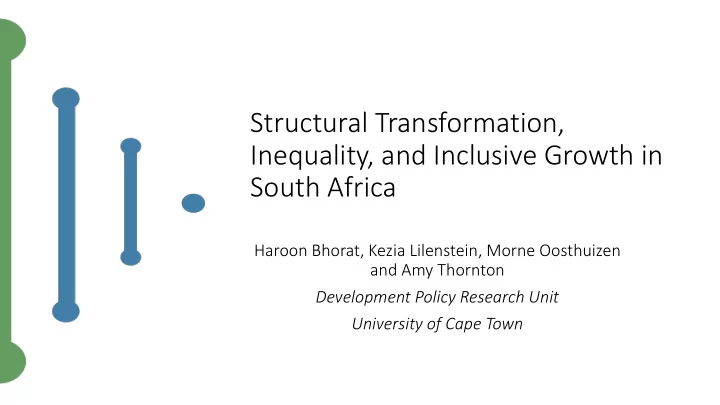

Structural Transformation, Inequality, and Inclusive Growth in South Africa Haroon Bhorat, Kezia Lilenstein, Morne Oosthuizen and Amy Thornton Development Policy Research Unit University of Cape Town
Outline • Economic History Prior to 1960 • Trends in Structural Transformation • Income Inequality, Employment and Inclusive Growth • Policies Shaping Structural Transformation, Inequality and Inclusive Growth • The Political Economy of Structural Transformation • The Future Trajectory of Structural Transformation, Inequality and Inclusive Growth
Economic History Prior to 1960s • Pre-WWII • Agri based before discovery of gold and diamonds end of 19 th century • Rise of mining – 1/3 global supply 1939 • Mines profitable on low-cost African labour • White Wm set through unions - earnings of White to African workers 10:1 during inter-war period. • WWII-1960s • Tripling of Real GDP • Start of industrialisation • Manufacturing output tripled between 1924 and 1939, despite the depression • 1948 - apartheid and discriminatory law • Jobs and skilled work reserved for White people • White welfare state: social assistance & generous state investment in White public education. • Spatial segregation: Africans in cities forcibly relocated to rural homelands, marginalised from economic opportunities. • Unemployment surged amongst African population in 1970s and remains high
Trends in Structural Transformation • Period I: Industrialisation (pre-1981) • Period II: Decline (1981 to 1994) • Period III: The post-apartheid period (post-1994)
GDP Growth, Value Added and Employment
Period I: Industrialisation (pre-1981)
Period II: Decline (1981 to 1994)
Period III: The post-apartheid period (post- 1994)
Income Inequality, Employment and Inclusive Growth - Current • 40% in 2015 • Africans - 47.1%; Whites - 0.4% Poverty • Unchanged or increased since 1994 • May be highest in the world – Gini at 0.69 despite being a middle-income country Inequality • Highest in the world? Narrow rate is 25%, 29% for Africans, 6% for Whites Unemploy ment • Growth peaked at 5.6% in 2006, trending downwards since • <2% in the last 5 years Inclusive • General failure of the economy to generate inclusive, pro-poor growth Growth
Policies Shaping Structural Transformation, Inequality and Inclusive Growth • 2003 - Broad-Based Black Economic Empowerment (B-BBEE) • 2018 – Social Grants • 18 million covered by social security, only 4 million in 1994 • Pension = 63% of median wage • Focus on Education Pupils entering Get to grade Qualify for Pass grade 12 50% 40% 12% school 12 University The South African education system is “ grossly inefficient, severely underperforming and egregiously unfair ”. -Spaull (2013)
Policies Shaping Structural Transformation, Inequality and Inclusive Growth Minimum Wages Real economic impact of apartheid powerfully felt in the labour market Expanded Employment Public Works Tax Incentive Programme
Result is: Wage polarisation and Increasing Inequality Annual Average Growth Rate of Real Employee Wages in South Africa for the Period 2000-2015
The Political Economy of Structural Transformation • Deep-seated antipathy between labour and business • Caused by alignment of colonial and apartheid state with business sector, centrality of labour in mobilising against apartheid • Extremely difficult to generate a national consensus with buy-in from all three social partners • High degree of concentration and economic rents create adverse incentives “[the] triumvirate of big business, government and organized labour is locked in a continual, boisterous public tussle over the distribution of the high rents being generated under the system” and economic rents create incentives to maintain the system. -Mahajan (2014)
The Political Economy of Structural Transformation • Weakening of a wide variety of state institutions in the last decade • Growing corruption and ‘state capture’ facilitated by insertion of complicit individuals into key positions of power. • Major SOEs and metros struggle to ‘keep the lights on’ and ‘keep the taps running’. • Strong resistance to using the international labour market to fill skills shortages. • Fiscus under increased pressure
Future Trajectory of Structural Transformation, Inequality and Inclusive Growth • Post-apartheid era characterised by failure to address inequality & achieve IG • Urgency is clear: working age pop is growing and unemployment continues to rise • Many developing countries have informal sectors absorbing ‘excess labour’, not true for SA. • Contrary to East Asian model, SA experiencing premature deindustrialisation • The case for a services-led growth path • Will unemployed be absorbed through growth path predicated on abundance of high-skilled employment? • Sub-sectors of services industry are fast-growing with capacity to absorb huge numbers of moderately skilled workers: tourism, wholesale &retail, transport & storage, catering & accommodation.
Future Trajectory of Structural Transformation, Inequality and Inclusive Growth • Importance of multi-pronged approach in tackling unemployment and growth problem • Manufacturing and industrialisation remain the focus of SA’s policy landscape for creating labour - intensive growth • Im Imperative to o develop a a str trategy promotin ing th the development of of in industries with ith an and with ithout sm smokestacks
Thank You!
Recommend
More recommend